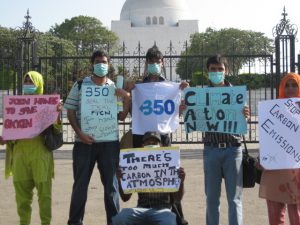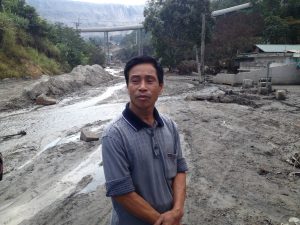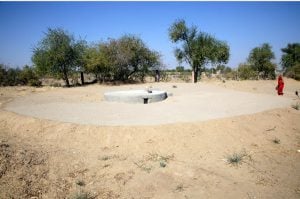Trekking and climbing trails in the Himalayas have long suffered from the rubbish discarded by walkers. The result: discarded food cans, plastic packets and every other kind of trash along once pristine mountains and streams.
A few years back, volunteers in Nepal and India formed squads to clean the trails. The initiative worked well, though it may now be getting overwhelmed by the sheer number of irresponsible visitors. This year, volunteers in Pakistan have joined the clean-up movement.
Some young residents of Baltistan in the Karakoram mountains have cleaned the rubbish in the tourist camps and on the 100 kilometre route to Concordia/K-2, the second highest mountain peak in the world. Plus, they have removed trash from the surface of the Baltoro Glacier in the Karakorum Range. Called the Baltoro/K2 Clean Up Expedition Camp 2015: Sustaining Eco-Tourism, the initiative was taken by 35 volunteers led by ten members of the Pakistan United State Alumni Network.
Over 20,000 trekkers and mountaineers take this route each year to reach the Concordia/K2 base camp. Much of their baggage is carried by mules, and one of the biggest problems faced by the clean-up crew was the carcasses of mules and other pack animals, abandoned in the snow.
In a two-week period – working in temperatures that sometimes plunged to minus 20 degrees Celsius – the volunteers ended up collecting 2,350 kilogrammes of cans, paper, plastic and animal carcasses. The waste was handed over to the Central Karakorum National Park (CKNP), which has a dumpsite.
Shamshad Hussain, the leader of the team, said they had taken the initiative to create a sense of awareness and responsibility. Tour operators must train porters and camp staff not to throw rubbish everywhere, he added.
Naek Nam Alam, General Secretary of Pakistan Tour Operators Association, blamed the government for not adopting a systematic and sustainable mechanism to collect waste from the area and dispose of it, despite receiving a fee from each tourist.
Before 2007, it was the responsibility of each tour group to collect its own rubbish. Then the job was given to an organisation called EV-K2-CNR, which has reportedly stopped doing it since 2013. Alam said rubbish disposal is now the responsibility of the CKNP authorities, under the forest and tourism department of Gilgit-Baltistan. Tour operators pay the provincial government US$68 per mountaineer and US$ 50 per trekker.
The government has formed a committee to oversee it, but Alam was unhappy with its work. He wanted the committee to be expanded to include officials, tour operators and environmentalists.
CKNP director Raja Abid Ali said it does collect rubbish at the end of every season. “We specially set up many camps for collecting the waste in every season and an incinerator has also been fixed in Askoli area to recycle and burn them.” He admitted “some shortcomings because of the huge area and lack of resources,” but added that the fee per climber had been brought down to US$ 68 from US$ 100, which was “totally insufficient”.
Some rubbish dumps are 50 years old and it is not possible to clear them quickly, said Ali, adding that CKNP staff had collected 3,050 kilogrammes of trash this year. When EV-K2-CNR was active, it had collaborated with CKNP to set up mobile toilets. Now these are lying unused, and are adding to the problem.
Polluted Everest trail
The rubbish is spread across the Himalayas. Every year over 700 climbers and their guides attempt to climb Mount Everest and leave trash behind. For the past few years, volunteers have been doing a clean-up, but that is proving inadequate.
Nepal Mountaineering Association’s President Ang Tshering Sherpa says measures taken to keep the mountains clean are inadequate. “Loaded porters and climbers return emptyhanded. That means they leave all the waste in the area every year. It needs a lot of money to collect all those cans, jars, oxygen cylinders and other material.”
From 2014, the government has made it mandatory for every climber to bring at least eight kilogrammes of waste back to the base camp. Anyone who fails to do so can forfeit anything between US$ 250 and 4,000, which is the deposit paid for the climbing permit, depending on the peak and the trail.
Climbers are not the only culprits. The famous trekking trail around Mount Annapurna in western Nepal sees about 100,000 visitors a year, and is getting dangerously polluted. Trekking companies claim they impose strict rules on their clients and staff.
“The team must destroy or recycle in front of the concerned government officials in the area and should bring back garbage that cannot be destroyed or recycled on the spot,” said Bodha Raj Bhandari, Chairman of Snowy Horizon Treks and Expedition, a tour operating company. Many locals say the rules need to be implemented more strictly.

Valley of Flowers
In India, the only way the authorities could save the famous Valley of Flowers in the Uttarakhand Himalayas was by banning all visitors for over ten years. Now that tourists are allowed again, there are strict instructions to guides that they will be prosecuted if any rubbish is left behind.
The biggest problem in India was at the Gangotri glacier, which is visited by thousands of pilgrims – being the source of the Ganga, a river holy to Hindus. Rubbish kept accumulating near the mouth of the glacier till a group of Hindu monks led by Rishikesh-based Swami Sivananda decided to start a clean-up campaign and a publicity campaign exhorting visitors to take their rubbish away. The moral authority they exercised worked to a large extent, though not entirely.
Two state governments in India – Himachal Pradesh and Sikkim – have attempted to tackle the source of much of the waste by banning plastic bags altogether. It works more easily in Sikkim, since almost all the traffic into the state goes over the same bridge. Even then, military officers posted in Sikkim had to call for volunteers to clean up some of the more popular trekking trails, especially in and around the Kanchenjunga National Park. In the shadow of the world’s third highest peak, this park gets overrun, especially in March and April, when the rhododendrons are in bloom.
The Rohtang Pass in Himachal Pradesh, on the route from Manali to Leh, is another area so popular and therefore so full of trash that India’s Supreme Court has had to step in and temporarily ban all tourist vehicles there altogether. There is now a plan among hotel owners in Manali to clean up the pass so that they can petition the apex court to lift the ban. But clearly, going back to business as usual will not work.








